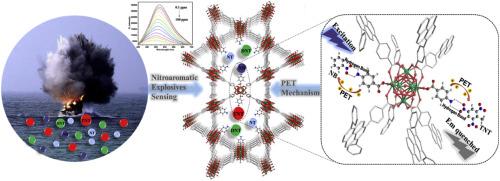Dyes and Pigments ( IF 4.1 ) Pub Date : 2022-12-22 , DOI: 10.1016/j.dyepig.2022.111035
Hangzhou Li , Qiumeng Chen , Zhixiao Zhang , Zhaoli Wang , Zhengjun Gong , Meikun Fan

|
The development and construction of fluorescent sensors with high sensitivity for nitroaromatics explosives detection is of great significance for national security and public environmental issue. Herein, the mechanism of photoinduced electron transfer (PET) was utilized to design a newly amino-functionalized luminescent Zr-based metal-organic framework (NU-1000-NH2) for ultra-sensitive fluorescent detection of nitroaromatic explosives, like 2,4,6-trinitrotoluene, 2,4-dinitrotoluene and 2-nitrotoluene. The amino constructed in cavities of NU-1000-NH2 can be served as recognition site to capture and bind the nitroaromatic molecules. Thus the rational design of NU-1000-NH2 has been proven an effective route to recognize the electron-deficient nitroaromatic explosives, causing fluorescence quenching of NU-1000-NH2 due to the electron donor (–NH2)–acceptor (-NO2) interaction. Moreover, hydrogen-bonding effect of intermolecular N–H···Oanalyte between NU-1000-NH2 and analytes was also found assisting for binding and recognizing of nitroaromatic explosives molecule. And the density functional theory (DFT) calculations were conducted to further investigate and quantitatively assess the molecule orbitals (MOs), interaction energies and electrostatic potential map, revealing the electron transfer process from conduction band (CB) of MOF to LUMO of nitro analytes and stronger interaction effect was obtained with more nitro groups of NEs. This study provided a feasible idea to design functionalized fluorescent MOFs for nitroaromatic explosives sensing based on PET and hydrogen-bonding effect.
中文翻译:

基于光诱导电子转移的功能化荧光 Zr-MOF 用于硝基芳烃爆炸物的高灵敏度检测
开发建设高灵敏度的硝基芳烃爆炸物检测荧光传感器,对国家安全和公共环境问题具有重要意义。在此,利用光诱导电子转移 (PET) 机制设计了一种新的氨基功能化发光 Zr 基金属有机骨架 (NU-1000-NH 2 ),用于硝基芳族爆炸物的超灵敏荧光检测,如 2,4 ,6-三硝基甲苯、2,4-二硝基甲苯和2-硝基甲苯。NU-1000-NH 2空腔中构建的氨基可作为识别位点捕获和结合硝基芳烃分子。从而合理设计出NU-1000-NH 2已被证明是识别缺电子硝基芳烃炸药的有效途径,由于电子供体 (–NH 2 )–受体 (-NO 2 ) 相互作用导致 NU-1000-NH 2荧光猝灭。此外, NU-1000-NH 2分子间N –H···O分析物的氢键作用还发现分析物有助于结合和识别硝基芳烃炸药分子。并进行了密度泛函理论 (DFT) 计算以进一步研究和定量评估分子轨道 (MO)、相互作用能和静电势图,揭示了从 MOF 的导带 (CB) 到硝基分析物的 LUMO 的电子转移过程和NEs的硝基越多,相互作用效果越强。该研究为基于PET和氢键效应设计用于硝基芳烃爆炸物传感的功能化荧光MOFs提供了可行的思路。

































 京公网安备 11010802027423号
京公网安备 11010802027423号